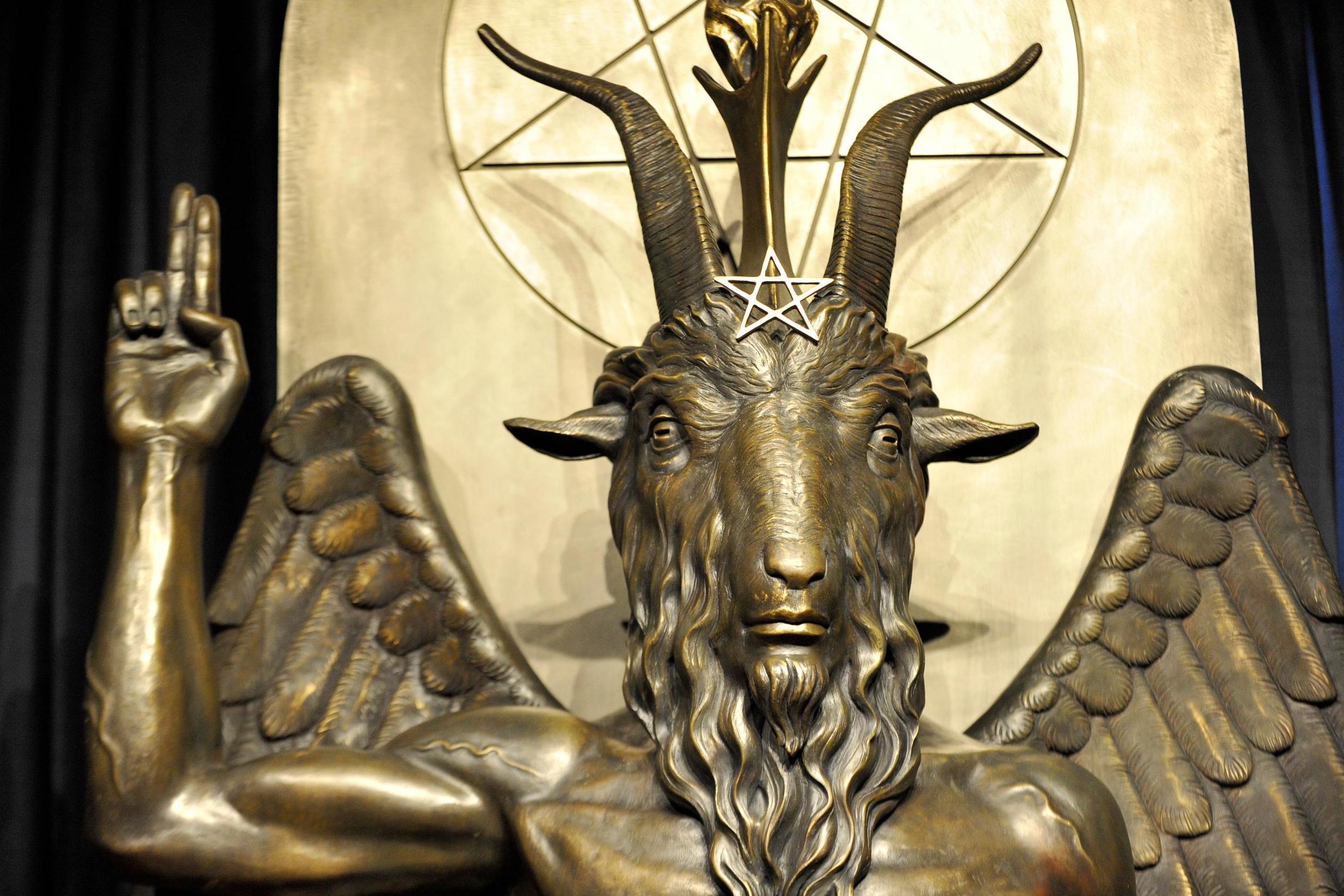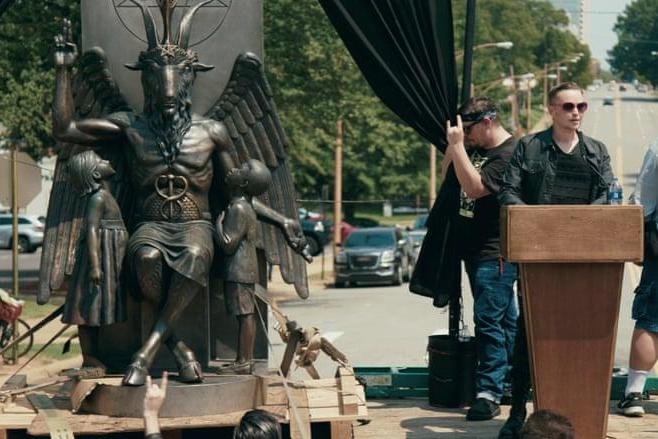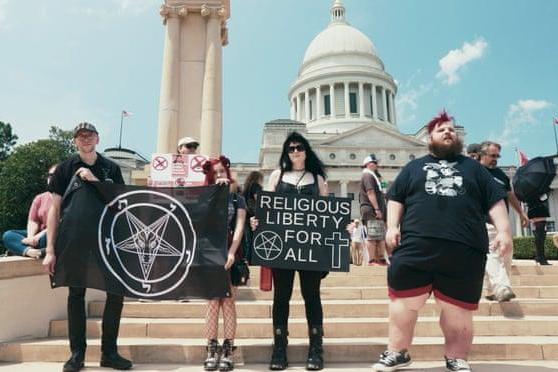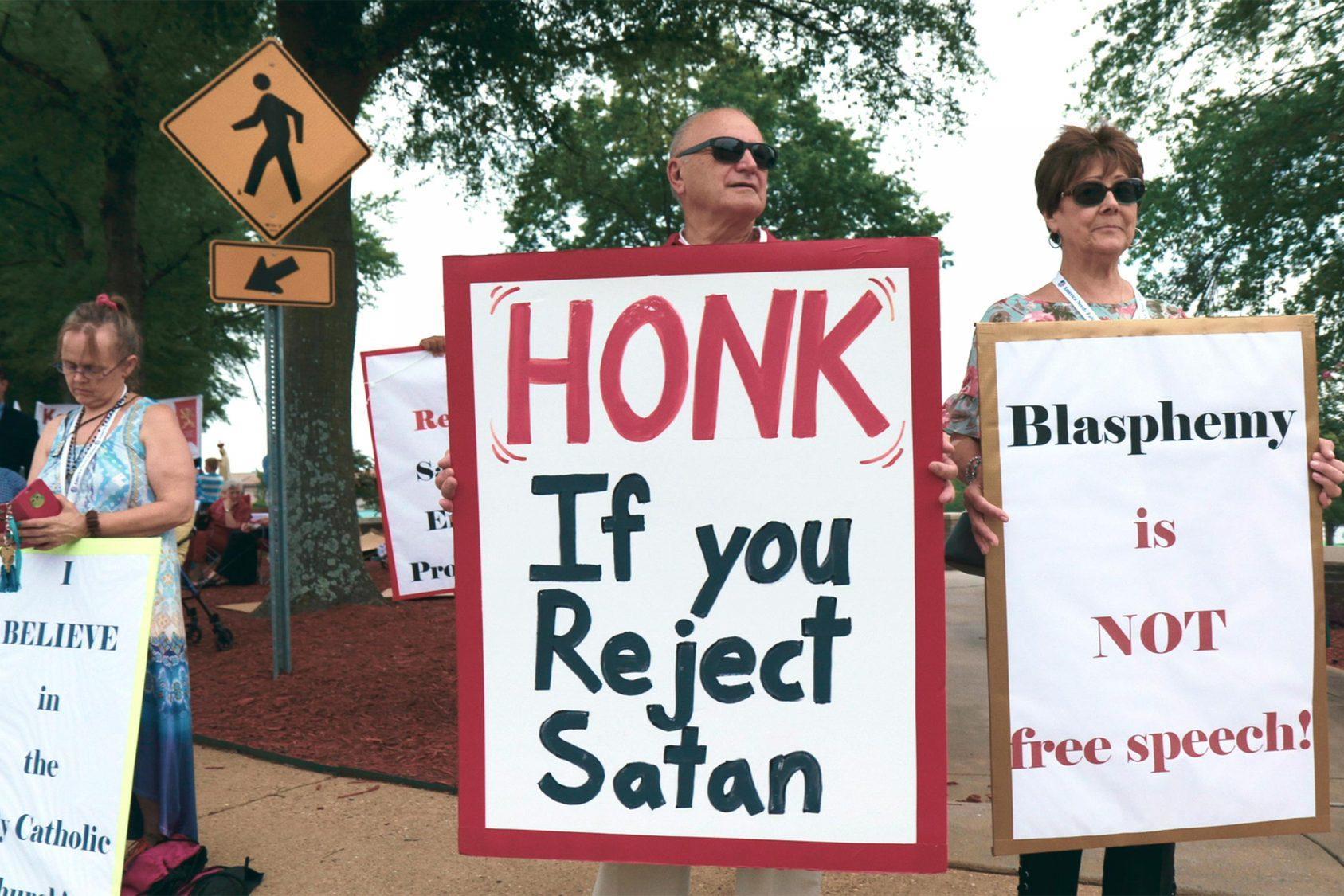How the Satanic Temple is turning the debate about religion upside down
Not to be confused with the Church of Satan from the Sixties, the modern organisation’s grassroots activism and clever deployment of humour might be exactly what the world needs right now, writes Holly Baxter


In November 2018, Netflix and Warner Brothers were sued over copyright infringement. The entity that sued them took issue with a particular statue in the Netflix show the Chilling Adventures of Sabrina, in which a teenage witch is preyed upon by a shady organisation populated by demons. The statue at the centre of the controversy is usually known as “Baphomet with Children”, and depicts a goat-headed figure with a pentagram on its forehead, the torso of a man and the wings of an angel. The entity suing Netflix over the effigy? None other than the Satanic Temple of the United States.
“The Satanic Temple is pleased to announce that the lawsuit it recently filed against Warner Bros and Netflix has been amicably settled,” wrote Temple co-founder Lucien Greaves on the religion-themed website Patheos in November 2018, before continuing to say that he was surprised by the amount of hate mail he and his compatriots had received after choosing to file the lawsuit. “When I read these things, I can’t help but wonder when the last time was that any of these angry commenters wrote to a public representative or approached any issue of importance in any way,” Dean added. “I particularly loved the confused claim from the people who said we were ‘playing victim’, with the alternative being that we simply stand silent when we feel our work may have been exploited. Interesting, too, are the almost equal numbers of those who say we’re being ‘just like Christians’ (though how is never made clear).”
The terms of the settlement remain confidential; we can presume that the Satanic Temple did not receive the $50m they asked for when they filed the suit in Manhattan, New York, arguing that their statue’s association with an evil cult in the Chilling Adventures of Sabrina would bring serious injury to their reputation. We know that they are now thanked in the credits of the show, which is a significant PR win for an organisation which relies on the shock factor and the associated googling it leads interested viewers to do. Any and all other details remain between the Satanic Temple, Warner Brothers and Netflix (a sentence few of us may have thought we’d ever read or write).
This is, however, not the first time “Baphomet with Children” has caused a ruckus in the US. The large statue, complete with its adoring two kids (one girl and one boy) staring up at the goat-headed deity depicted, was unveiled during a rally at the Arkansas State Capitol in 2018. In 2015, the Satanic Temple similarly attempted to force the state of Oklahoma to install a version of Baphomet in their State Capitol building. If these strange attempts to publicly espouse their views sound worryingly cultish and evangelical, they’re supposed to: they were done in response to a Ten Commandments monument being put on display in both instances. When the line between church and state becomes blurry in the United States, the Satanic Temple is there; though Dean makes it clear that they no longer focus solely on “church/state issues”, their big media moments have involved such audacious challenges to Christian iconography for obvious reasons.
There is more to the Satanic Temple than Baphomet, however, and during Donald Trump’s presidency especially it has moved beyond being a one-issue organisation. Its tagline – “Empathy. Reason. Advocacy” – could easily be the mantra of a progressive pressure group like the American Civil Liberties Union, with which it has much in common. In fact, the way in which its founders describe it in further detail wouldn’t be out of line with a Tea Party manifesto or a constitutional amendment. It is certainly unabashedly American in the way that it describes the need to “reject tyrannical authority, advocate practical common sense, oppose injustice, and undertake noble pursuits”. A unifying force between the left and right, however, it is not.
The Temple has its own version of commandments, though they are known as the “seven fundamental tenets” and they depart from the ten Christian commandments fairly swiftly. “One’s body is inviolable, subject to one’s will alone,” is tenet number three, explaining why satanists often turn up with black and red themed placards at pro-choice marches. “Beliefs should conform to one’s best scientific understanding of the world. One should take care never to distort scientific facts to fit one’s beliefs,” is tenet number five, underscoring the Temple’s knowledge-seeking ethos (there are no evil trees of knowledge here, no snakes which can tempt the righteous away from enlightenment by offering up education which is beyond one’s means. All education is seen as inherently good, and pursuing it a noble goal.
“People are fallible. If one makes a mistake, one should do one’s best to rectify it and resolve any harm that might have been caused,” reads tenet number six, a rule that one might say is especially important to remember in a world punctuated by Twitterstorms and public digital flagellations. Similarly, tenet number four reads: “The freedoms of others should be respected, including the freedom to offend. To willfully and unjustly encroach upon the freedoms of another is to forgo one’s own.” Perhaps if Republicans scandalised by horned beasts and pentagrams took a second to read the rules of the Satanic Temple, they might find themselves just as on board with its aims as progressives.

“We have publicly confronted hate groups, fought for the abolition of corporal punishment in public schools, applied for equal representation when religious installations are placed on public property, provided religious exemption and legal protection against laws that unscientifically restrict women’s reproductive autonomy, exposed harmful pseudo-scientific practitioners in mental health care, organised clubs alongside other religious after-school clubs in schools besieged by proselytising organisations, and engaged in other advocacy in accordance with our tenets,” the Satanic Temple details in its reading material for outsiders. It gives the idea that people might join up to actually worship Satan short shrift: under its Q&A section, the answer to “I want to sell my soul, get rich, join the Illuminati, etc” is simply “Please look elsewhere”.
But despite its playful-seeming website, with its upside-down crosses and its “Hail Satan, Est. 666” T-shirts (as well as a goofy “After-School Satan” version for kids), the Satanic Temple considers itself a serious organisation with serious aspirations. Its New York chapter even published a guide to anti-racist protest during the recent Black Lives Matter demonstrations, in which Satanic Temple member Robyn Graves (who I presume writes pseudonymously, though perhaps her parents were simply hardcore advocates of the dark arts) wrote at length about white supremacy and patriarchy, ending with: “We are unified under satanism, by the tenets, and by our collective urgency to obliterate racism and the systems that allow it to remain a part of our lives. Racism is our adversary; it’s an obstruction of justice and we must resist it and think critically to overcome it.
As Lilith stated in the Alphabet of Sirach, ‘I will not lie below. We are equal to each other inasmuch as we were both created from the earth.’ Finally, to cite the Invocation, ‘Let us stand firm against any and all arbitrary authority that threatens the personal sovereignty of One or All.’ Hail Lilith! Hail Satan! F**k Racism!” A chapter member named Ian commented underneath: “Who’d have thunk that, 2,020 years after some guy was supposedly nailed to a tree for saying ‘don’t be an a**hole’, leading to the founding of numerous religious sects that today act mainly out of hatred and fear, the satanists would be the only religion getting it right?”
And it’s hard not to agree with Ian. The Temple may do some outwardly silly things, though they’re usually for profoundly non-silly reasons. Commissioning “Baphomet with Children”, for instance, which they did in 2014 in partnership with the artist Mark Porter, may seem slightly ludicrous. Certainly, unveiling it to a “crowd of devotees in Detroit”, as they did in July 2015, and then marking the occasion with a religious holiday called Unveiling Day, seems deliberately odd. But carrying the statue to protests and using it to draw attention to the zealotry of some Christians in the American Deep South is smart. It makes its point far better than any number of reasonable speeches or well-meaning cardboard signs might. Arguing that a large installation of the Ten Commandments is harmless becomes much harder when a larger-than-life half-human Satanic deity has just been unveiled right next to it in the most authoritative building in the state.

Similarly, the Satanic Temple may provide teenagers with much fodder with which to irritate their parents, but it has also committed to enacting change among high school graduates in innovative ways. The superbly named Devil’s Advocate Scholarship, which was launched a couple of weeks ago, will award $500 to two graduating students who can answer a fairly straightforward question – “What initiatives have you undertaken that are consistent with TST’s tenets and mission?” – or a tongue-in-cheek one clearly designed to subvert the “inspirational teacher” type questions commonly asked during scholarship interviews – “Please discuss and describe in detail any one of the teachers who crushed your spirit, undermined your self-confidence, and made you hate every minute you were forced to be in school.” Though $500 is a relatively small amount in a country where student loans can stretch to $100,000 or more, the prize is intended to contribute to the applicant’s “learning, rather than schooling”. In other words, it’s fine to use it for travel, personal enjoyment or a short online course of their choosing.
The fact that pretty much every Satanic Temple activity or idea is harmless at worst and positive at best does not mean that it hasn’t faced controversies. In 2017, Temple chapter head Michelle Shortt had her invitation to speak at a council meeting in Scottsdale, Arizona, rescinded for what TST considers spurious reasons. Shortt had wanted to give an invocation at the council meeting, since city officials were allowed to open with such speeches and Christian churches had been taking advantage of the rule for a number of years. The Satanic Temple launched a lawsuit, which is still ongoing, and which periodically leads to tidbits of information hitting the press. One such tidbit appeared a few months ago, in January of this year, when it was revealed that a Scottsdale city employee had received over 15,000 emails from one local Christian church protesting against the idea of a Satanic invocation.

Still, other protests and initiatives led by the Satanic Temple are ongoing. One, which works in tandem with a mental health organisation called Grey Faction, specifically opposes “recovered memory therapy”, a controversial psychiatric method which claims that victims of trauma can suddenly recover repressed memories during therapeutic sessions and which has led to numerous claims about childhood Satanic rituals, especially during the infamous American “Satanic panic” in the 1980s. One might say that the Satanic Temple has skin in the game in this particular initiative, though the founders say that they oppose the practice simply because it is anti-scientific (it’s also worth bearing in mind that Grey Faction’s aims are supported by a number of prominent and respected scientists and academics, including Professor Richard McNally from the Department of Psychology at Harvard University). Another campaign that continues under the banner of the Satanic Temple concerns challenging the proliferation of religious literature in schools; another encourages protests in states where medically accurate information is withheld from people seeking abortions. The Protect Children Project, also run by the Temple, opposes corporal punishment in schools and pays for billboards which read, “Our religion doesn’t believe in hitting children”. During the aftermath of the Boston Marathon bombings in 2013, and in response to the Westboro Baptist Church (those of the famous “God Hates Fags” placards) pledging to picket the funerals of the victims, the Satanic Temple took retaliatory action at the gravesite of the mother of Westboro Baptist founder Fred Phelps. “The ritual was conceived to make Fred Phelps believe that the Satanic Temple had turned his mother gay in the afterlife and succeeded in invoking the ire of the Westboro Baptists,” wrote Lucien Greaves.

There is a clear liberal agenda to the actions of the Satanic Temple, then, but also an undeniable undercurrent of what might best be referred to as trolling. Like the British non-theistic society Humanists the UK but with a sardonic edge, TST is not above the sort of eye-for-an-eye tomfoolery that religious evangelicals in the US equally engage in. It is not, in other words, a straight-laced organisation with a prestigious reputation to uphold, and it does not “go high” when others go low. While it may pursue genuine litigation and stand for some admirable values, the founders are clearly well aware of the certain advantages an eyebrow-raising name and a black website replete with ancient symbology can afford. “The Satanic Temple is often confused with an earlier organisation, the Church of Satan… much to our chagrin,” the co-founders wrote in their mission statement. “Chagrin” might be a little strong in reality; one can imagine them typing out that sentence with a lopsided grin.
The Temple is not exactly welcoming to journalists poking around, which I found out while writing this article and repeatedly attempting to contact its founders (though I discussed the Devil’s Advocate Scholarship and the Temple’s upcoming “new push for reproductive rights”, which begins officially on 5 August, the Temple’s press officer, Molly Jacobson, disappeared into the ether when I asked if I could interview Greaves or another higher-up member of the Temple). It’s somewhat surprising, then, that the 2019 documentary Hail Satan?, which details the work of TST, was made in the first place. Director Penny Lane reportedly spent a lot of time laying the groundwork with Temple officials and agreed to a number of restrictions, including no “set-up” shots and no reshoots: everything had to be authentically presented and if she didn’t catch it on camera right the first time, too bad.

The documentary, which was advertised with a doctored image of the Statue of Liberty as Baphomet, his goat horns dyed green and Lady Liberty’s torch replaced with a two-finger salute, was described as provocative at the time but really its provocations only extend to the fact that it engages seriously with something calling itself satanism. In it, Satanic Temple members donate socks and menstrual items to homeless shelters and host blood drives in Seattle. “I’ve always toed the straight new atheist line when it comes to religion, like religion is stupid and religion is dumb and we should just get rid of it and the world would be better off if everyone just dropped the stupid religion thing and I have totally changed my mind on that,” Lane said not long after the documentary was released.
“I just think we should be reconsidering what kind of religions might exist going forward, ones that will better fit the reality we live in … The Satanic Temple is a look at what religion should be. If we’re starting from scratch, what kind of religion would you want to have? Would you want to have a religion that asks you to have blind faith in frankly ridiculous ideas or to persecute others based on their lack of understanding of your one true way or would you want it to be about rational thought or empathy or compassion and pluralism?” Though the Temple is decidedly, consciously non-theistic, its absence of deity worship does not mean that it is not exactly religious in its form or scope: as Lane says, it is a modern kind of religion, one that does away with a lot of the magic and miracles and keeps the community aspect, as well as the focus on how to live your life.
Hail Satan?, like the Temple itself, is confusing, hilarious and intelligent at different points. Its form of activism – grassroots efforts to bring food, clothing and sanitary products to the needy aside – is often bizarre but its leaders are empathetic and sincere. I have seen a lot of anti-abortion protests outside reproductive health clinics in my time, but the Satanic Temple’s “baby fetish” counter-protest outside Planned Parenthood in Ferndale, Michigan, is probably the most novel way I’ve seen one contended with. Videos online showing adults dressed as babies in bondage gear gathering alongside Christian evangelicals singing hymns, while smiling women in black dresses hold up signs that read: “THE FUTURE OF BABY IS NOW.” Writhing on the floor in BDSM gear, the Satanic Temple demonstrators look certifiably insane, but their message is clearly made: opposing women’s bodily autonomy is so stupid as to be nonsensical. The only logical response is ridicule.
Is this the future of progressivism? It’s doubtful. But the Satanic Temple of the United States does provide an excellent outlet for the lowbrow humour it’s sometimes necessary to partake in to survive the far-right presidency of Trump. There will be plenty of self-righteous speeches in the House and the Senate, plenty of time to articulately take Ted Yoho to task for sexism, plenty of time to pontificate about the importance of tackling climate change. The lofty aims of the Democratic Party are, hopefully, a blueprint for the future of America. The Satanic Temple, in contrast (or in association), is a blueprint for how to poke fun at what we British expats in the US might call the gammons of the country. Beyond that, it is a blueprint for how to get right under their skin. With a host of successful legal battles under its belt and possibly the only documented achievement of really riling up Fred Phelps, it’s clear that TST means business. That business might not save the world on its own, but in a place where sex education means teaching abstinence and accessing abortion means battling through lines of protesters holding crosses to reach a clinic with bulletproof windows, it’s still a vitally important contribution. And through its clever deployment of humour and its stubborn refusal to ever be holier-than-thou (no pun intended), it might just save your sanity.
Join our commenting forum
Join thought-provoking conversations, follow other Independent readers and see their replies
0Comments